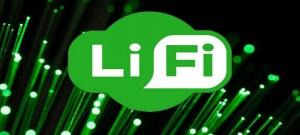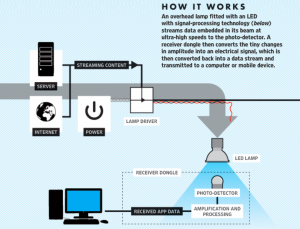 Imagine a world where every one of the billions of lightbulbs in use today is a wireless hotspot delivering connectivity at speeds that can only be dreamed of with Wi-Fi. That’s
Imagine a world where every one of the billions of lightbulbs in use today is a wireless hotspot delivering connectivity at speeds that can only be dreamed of with Wi-Fi. That’s
the goal of the man who invented such a technology, and this week Li-Fi took a step out of the domain of science fiction and into the realm of the real when it was shown to deliver speeds 100 times faster than current Wi-Fi technology in actual tests.
An Estonian startup called Velmenni used a Li-Fi-enabled lightbulb to transmit data at speeds as fast as 1 gigabit per second (Gbps), which is about 100 times faster than current Wi-Fi technology, meaning a high-definition film could be downloaded within seconds. The real-world test is the first to be carried out, but laboratory tests have shown theoretical speeds of 224 Gbps.
So, just what is Li-Fi, how does it work, and will it really revolutionize the way we connect to the Internet?
Li-Fi refers to visible light communications (VLC) technology, which delivers high-speed, bidirectional, networked mobile communications in a manner similar to Wi-Fi. It promises huge speed advantages, as well as more-secure communications and reduced device interference.
Who Invented Li-Fi?
The term was coined by German physicist Harald Haas during a TED Talk when he outlined the idea of using lightbulbs as wireless routers. That address was delivered four years ago, and many people speculated that, like a lot of apparent revolutionary breakthroughs, Li-Fi would go the way of other “next big things” and not come to fruition. A year after his TED Talk, though, Haas, a professor of mobile communications at the University of Edinburgh, created pureLiFi with a group of people who had been researching the technology since 2008. The company has claimed to be the “recognized leaders in Li-Fi technology” and has already produced two products.
On Wednesday, pureLiFi announced a partnership in which a French industrial-lighting company will roll out the firm’s VLC technology in its products by the third quarter of 2016.
 Will It Work With Any Lightbulb?
Will It Work With Any Lightbulb?
Haas said during his Ted Talk in 2011 that the current infrastructure would allow every single LED lightbulb to be transformed into an ultrafast wireless router. “All we need to do is fit a small microchip to every potential illumination device and this would then combine two basic functionalities: illumination and wireless data transmission,” Haas said. “In the future, we will not only have 14 billion lightbulbs, we may have 14 billion Li-Fis deployed worldwide for a cleaner, greener and even brighter future.”
Is There Any Downside?
Because Li-Fi technology uses visible light as its means of communication, it won’t work through walls. This means that to have a Li-Fi network throughout your house, you will need these lightbulbs in every room (and maybe even the fridge) to have seamless connectivity.
Another major issue is that Li-Fi does not work outdoors, meaning that public Li-Fi will not be able to replace public Wi-Fi networks any time soon. While Li-Fi’s employment in direct sunlight won’t be possible, pureLiFi said that through the use of filters the technology can be used indoors even when sunlight is present.
By David Gilbert for International Business Times

0 Comments